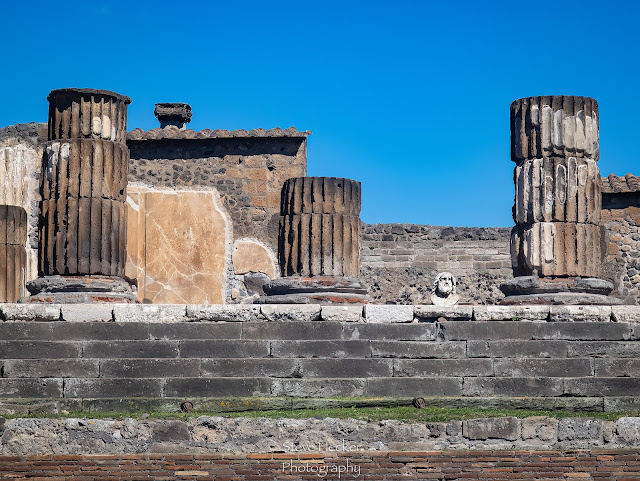Italy: Pompeii: 3 of 12
Crafting this post has a difficulty factor of about 9.9, for several reasons.
First, we arrived early to the site in order to beat the crowds - which was a big plus. It worked.
However, rather than having overhead, more midday sun, we had early sun, so long shadows. I tried to take advantage of the drama but was not able to conquer the challenge.
Second, the ruins did not lend themselves to my photo-narrative eye. It was a hard shoot.
Last, our visit followed the Sorrento-Amalfi excursions, which were landscape-gorgeous, and it was hard switching gears.
Let's begin with a brief intro to this most fascinating city:
Pompeii was a thriving seaport, just south of what is now Naples. It was a marvel of urban planning, municpal innfrastructure, and artistic and architectural excellence. Streets and a clean water supply were vital conveniences for residents. Merchants grew rich on trade, and local restaurants/bars and bakeries did brisk business. Every block had a well.
Upon our entry to the city, a striking figure in repose... a cast of a victim, buried under perhaps twenty feet of ash. This is a life-sized artifact:
Quoting the Garden of the Fugitives Wikipedia entry:
The Fugitives were uncovered by Amedeo Maiuri, the superintendent of Pompeii. They were uncovered in 1961 as hollow cavities where the flesh had rotted away. When filled with plaster of paris, the bodies of the victims were revealed. They were originally found in three smaller groups.
And while we're on the Wiki side of the information stream, https://en.wikipedia.org/wiki/Pompeii is a most informative read. Most of the Pompeii deaths are now (as of 2010) thought to be not from the ash, but rather from heat... the pyroclastic flow could have been as hot as 250 degrees C, or 480 degrees F. Death would have been instant.
With research still ongoing, it is now (2011 to date) thought that the Pompeii population numbered 11,500. Since there have been 1,150 bodies discovered at the site, it is said the population estimate "seems reasonable." It is theorized that in the two-day eruption back in 79 AD, the first day was the ash wave which gave many residents an opportunity to escape.
Day two was the pyroclastic flow.
And as of 2022, those two fateful days are believed to have been October 24 and 25, 79 AD (or CE).
Let's turn to the walking tour of 2025:
A street... note the original pavers. There are ruts on either side at the curbs. where wagon wheels would travel. The street, one of many that are restored, is one wagon wide. Thus, all streets were one-way.
Each of the vertical brick structures mark the width of houses (or shops, it depends). This (above) would be a less well-heeled part of town due to the narrowness of the residences.
Casa del Fauno, House of the Faun, Entrance on Via della Fortuna... this was a home of a more well-to-do resident
Excavated 1829 to 1833, 1900, 1930, 1960. Bombed 1943. Reconstructed 1945. pompeiiinpictures.com
Taking a closer look inside one of the residences, a garden. In the style of the day, this was the first "room" of the house, visible from the street, and designed to let all passersby know just how successful the owners/occupants were:
Note the "birdbath" to the left, and the wall decorations to the rear - as well as the well-endowed statue in the foreground.
Interior details are below... the "birdbath" (actually a sink) and a water pipe in the floor, which encircles the garden, making a 90-degree turn; also, the restored wall treatment...
Wall restoration detail (2 images):














Comments